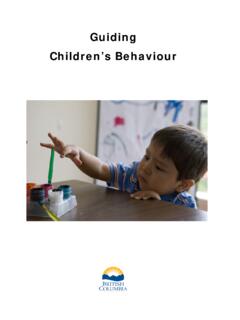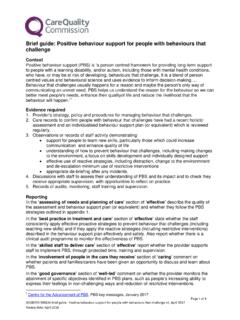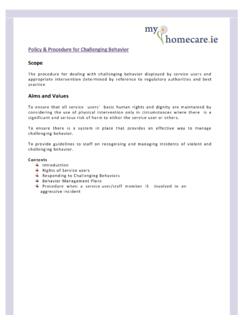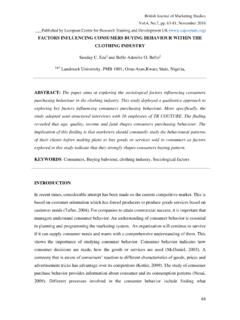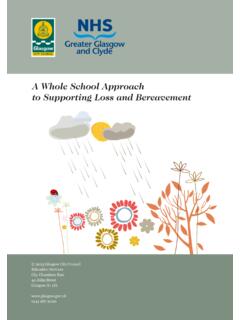Transcription of Methods and approaches to understanding behaviour change
1 Helpdesk Research Report Methods and approaches to understanding behaviour change William Robert Avis Question Describe the scope of approaches and Methods to understanding behaviour in international development. Describe the scope of the use of research driven processes towards addressing behaviour change in development (with a focus on Health, Education, Social Protection and Livelihood Development). Review the current initiatives to understand and respond to behaviour change in Uganda and Karamoja. Contents 1. Overview 2. Theories/models of behavioural change 3. behaviour change in international development 4. behaviour change in Karamoja, Uganda 5. References 1. Overview A behaviour change method is considered to be any process that has the potential to influence individuals and behaviour .
2 There are a large number of theories and approaches towards behavioural change derived from disciplines such as psychology, sociology, communication and political science. These can focus on the enabling environment level, the community level, the interpersonal level, or the individual level. This rapid review draws on academic and grey literature to present a broad overview of theories and models of behaviour and behaviour change . It highlights their adaptation and application to the field of international development and how they can further an understanding of behaviour in Karamoja and of mechanisms to affect behaviour 1 The review draws on Avis (2016) and the impact of protracted crisis on attitudes and aspirations in Karamoja.
3 2 GSDRC Helpdesk Research Report Given the range of theories and models that discuss behaviour change , no single behaviour change method is universally applicable, rather, research suggests that behaviour and behaviour change can be best understood when an open theory approach is adopted. This entails an appreciation of the diversity of behavioural theory that can enhance the assessment of a range of issues. An open theory also acknowledges that the translation of theoretical Methods to specific contexts, populations, and cultures is often challenging. This distinction between theoretical Methods and practical applications is crucial for two reasons: i. Evidence of the effectiveness of behaviour change Methods is generally only available for generic behavioural Methods .
4 Ii. behaviour change Methods are only effective if the parameters for effectiveness are met. Intervention descriptions are incomplete when they do not describe both which theoretical Methods they use and to which practical applications these were translated. Key findings of this rapid review include: Information alone is insufficient to support behaviour change . Influencing healthy behaviours and creating a supportive social environment in a variety of contexts requires stimulation of learning and participation through regular dialogue with the affected community. This type of behaviour change communication and social mobilisation works best when actions, messages and materials are strategically planned, managed, and monitored with the affected communities and supported by the necessary financial and human resources.
5 Relationships with partners, families and the community or society in which one lives can substantially determine how we behave. behaviour change interventions need to take into account the specific psychological and social influences that guide decision making and behaviour in a particular setting. That means that the process of designing and implementing effective interventions needs to become a more iterative process of discovery, learning, and adaptation. What matters is not only which policy to implement, but also how it is implemented. 2. Theories/models of behavioural change A behaviour change method is considered to be any process that has the potential to influence psychological determinants (Glanz et al.)
6 , 2005). Psychological determinants are theoretical variables that influence individuals (and communities) behaviours (Glanz et al., 2005). Examples of such determinants include attitude, risk perception, self-efficacy and habit. These determinants are included in theories of behaviour explanation such as the Health Belief Model. Other theories explain how such determinants may be changed, for example Social Cognitive Theory etc. There are a large number of theories and approaches towards behavioural change derived from disciplines such as psychology, sociology, communication, and political science (CommGAP, 2009). These can focus on the enabling environment level, the community level, the interpersonal level, or the individual level (C- change , 2010).
7 It is important to note that no single behaviour change method is universally applicable; some Methods may be more appropriate choices than others depending on context, target population of intervention and the practical applications that can be used. In many cases theorists have contributed towards multiple approaches and these approaches are not mutually exclusive Methods and approaches to understanding behaviour change 3 of each other. Examples of well-known, and frequently applied, behaviour change Methods are fear appeals, persuasive communication, and modelling (Glanz et al., 2002; C- change , 2010). CommGAP (2009) identify the main theories of social behaviour as: Social Cognitive Theory, the Theory of Planned behaviour and the Stages of change /Transtheoretical model.
8 Rao (2012) notes that while these theories have their value in specific contexts, their often unquestioned use, particularly of the Theory of Planned behaviour and the Stages of change /Transtheoretical model, is highly problematic. Instead, Rao (2012) advocates an open theory approach, where an appreciation of the diversity of behavioural theory is incorporated into the assessment of issues. This open theory approach incorporates a range of disciplines that can contribute to the understanding of a behavioural challenge and intervention options selection. C- change (2010) present one example of an open theory approach: This initiative developed tools for Social and behaviour change Communication based on a wide range of theories and approaches to behaviour change .
9 These approaches are summarised as follows (Rao, 2012): Enabling environment level Media theories Mass media can focus attention on issues, generating public awareness and momentum for change . Research on agenda setting has shown that the amount of media coverage of a given issue correlates strongly with public perception about its importance. Agenda dynamics refer to the relationship between media agenda (what is covered), public agenda (what people think about), and policy agenda (regulatory or legislative actions on issues) (Dearing & Rogers, 1996). Media advocacy is how civic action groups promote social change through various techniques and persuade the media to cover issues considered important refers to civic actions to shape media attention on specific issues (Wallack, 1993).
10 Framing is how issues are presented in news coverage (Iyengar, 1991). Experimental research shows that news frames influence how people perceive issues and think about possible courses of action. Persuasion is a form of communication that seeks to influence attitudes or behaviours without the use of force or coercion (Perloff, 2003). Perloff (2003) provides a comprehensive introduction to persuasive communication and attitude change , offering a discussion of classic and contemporary theories of persuasion, exploring the structure and functions of attitudes, consistency between attitude and behaviour , and issues in attitude measurement. Key questions include: How can the media contribute to changes in the enabling environment?










